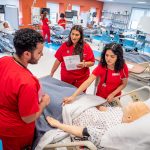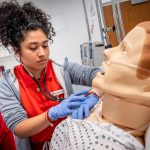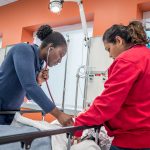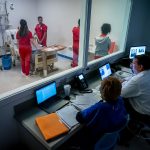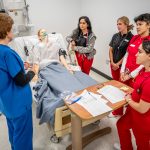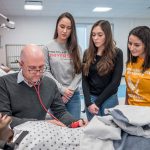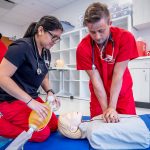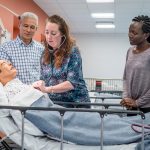Skills Training Laboratory
The skills training laboratory serves as the main learning hub for the Simulation Center. By using various simulators and task trainers, students are able to practice medication administration, dressing changes, trach care and suctioning, inserting foley catheters, taking vital signs and many other nursing skills.
Home Health Care Suite
The home health care suite allows our students to simulate health care situations in a home setting. With so much of modern health care being performed in the home, we found it critical that our students were trained to meet the unique needs associated with this environment.
Fully-Mediated Lecture-Style Classrooms
These classrooms are used in the delivery of lecture-style course content, pre-briefing activities and debriefing sessions. Streaming capabilities allow nursing students to watch simulations being done in the lab in real-time.
High-Fidelity Control and Simulation Rooms
These high-fidelity rooms replicate a standard hospital room and are adapted for providing care across the lifespan and healthcare continuum. Each room is equipped with the most current technologies, including audio and video recording capabilities, monitors, electronic health records, and high-fidelity simulators. These resources prepare students to safely transition from the academic setting to the clinical environment.
Health Assessment Rooms
Our health assessment rooms replicate office spaces similar to that of a primary care practitioner and are primarily used in Health Assessment and Advanced Health Assessment to help students develop assessment skills that will be replicated in the clinical environment. These rooms are equipped with audio and video recording capabilities to allow for effective debriefing of simulated and standardized care scenarios.
Simulated Cadaver Table
The technology provided by the Anatomage Table 8 (simulated cadaver table) allows nursing students to interact with internal anatomy and active physiological responses inside the human body. This technology is used in Anatomy and Physiology I & II, Pathophysiology, Advanced Pathophysiology and Health Assessment.
Simulation Center Photo Gallery
- 4-year BSN students in the skills training laboratory.
- 4-year BSN student conducting a simulated scenario in a high-fidelity simulation room.
- RN to BSN students in the skills training laboratory.
- Faculty members demonstrating the Anatomage Table 8.
- Faculty members observing 4-year BSN students conducting a simulated scenario.
- A faculty member debriefing with students after a simulated scenario.
- A faculty member demonstrating functions of an intelligent simulator.
- 4-year BSN students practicing CPR skills in the training laboratory.
- Students demonstrating functions of an intelligent simulator.

